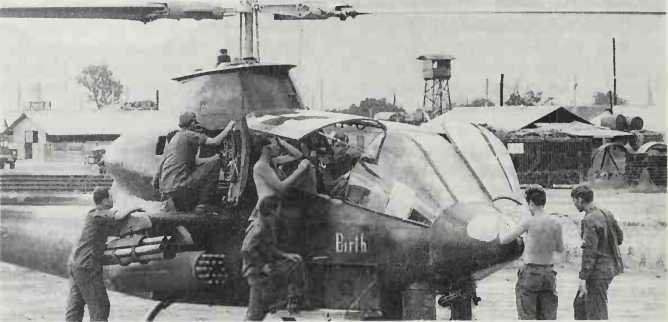

Arming an American AH-IG Cobra attack helicopter (“gunship”!, Vietnam
Region of Arabia and by 1908 had linked Damascus with Medina although the extensions to Mecca and Aqaba had not been completed by 1914. The railway greatly facilitated Turkish military control of the Hejaz and was therefore a primary target during the Arab Revolt. Arab guerrillas kept substantial Turkish garrisons pinned in the towns along the railway and severely dislocated communications by constantly raiding the line. MS.
Helicopter medical evacuation (Korea). This was hastily improvised in the first months of the Korean War, employing the 3rd Air Rescue Squadron of the usaf to carry casualties from the front line to Mobile Army Surgical Hospitals. A shortage of helicopters meant that only the most severely wounded could be evacuated by this method and the usaf always insisted that the primary mission of its helicopter units should be rescue. In the course of the war, the army acquired its own helicopters, which became responsible for transporting casualties within the combat zone. On the un side, thanks to helicopters, a severely wounded soldier could be undergoing surgery within an hour. Chinese and North Korean wounded took at least a day to reach any kind of hospital, by which time the worst cases had already died. CM.
Helicopter. An aircraft normally deriving its lift and thrust from the aerodynamic resultant of horizontally-mounted rotating wings, or rotors. Directional control in most helicopters is obtained by varying the pitch of a tail-mounted rotor, counteracting the torque generated by the main rotor system. Early military helicopters (1940s and 50s) were suitable only for reconnaissance, light cargo and liaison, and the evacuation of casualties from the forward combat zone. However, development of lightweight gas turbine engines led, in the 1960s, to great improvement in performance and extension of helicopter roles. The French army began to arm its helicopters during the Algerian campaign (1954—62), and as the result of lessons learned in Vietnam the US army introduced the purpose-built UH-1 Cobra attack helicopter, designed around various weapon systems, protected by integral armour from the effects of hostile fire, and manned by specially trained crews. An attack helicopter (or “gunship”) will normally mount a mixture of anti-tank guided missiles, free-fiight rockets, and cannon or machine guns. With the appearance in the Soviet inventory of helicopters clearly designed to attack opposing helicopters in flight, it is becoming necessary to mount air-to-air weapons on many NATO battlefield helicopters.
Armies are increasingly reliant on larger types of helicopter, capable of moving formed bodies of troops and their equipment rapidly to wherever a tactical decision is required. These can be as large as the Boeing-Vertol Chinook, classified as medium-lift, or smaller 'support helicopters such as the Aerospatiale Puma and the Sikorsky S-67 Blackhawk. Helicopters have been used at sea since the mid-1940s with conspicuous success in anti-submarine, countermine and amphibious assault roles. Advanced-technology rotor blades, the use of titanium, high efficiency power plants, and advanced flight control systems all feature in contemporary designs. Although early machines had only a limited capacity for operations by night and in adverse weather conditions, the need for 24-hour battlefield support and for survival in increasingly hostile combafcon-ditions has resulted in improved navigational aids. Passive and active sensors for target acquisition and surveillance now permit the deployment of helicopters in virtually all conditions as 24-hour battlefield vehicles. MH.
Heligoland Bight (August 1914). North Sea naval engagement. On August 28 1914, Commodore Reginald Tyrwhitt’s light cruiser and destroyer force moved into the Heligoland area against patrolling German flotilla units. The Admiralty had not informed Tyrwhitt that it had also deployed a light cruiser force (Commodore W R Goodenough) and a battle cruiser squadron (Vice Adm Beatty) in support. A British decoy submarine attracted German light cruisers and destroyers, and in confused daylight engagements the German lost three light cruisers and a destroyer. But Admiralty planning had been seriously defective and the success was largely attributable to good luck and to poor German dispositions. JTS.
Hellcat, Grumman F6F-3/5 (US, WWII). Single-seat shipboard fighter. Prototype flew June 26 1942; first production aircraft October 30 1942; first deliveries to US Navy Fleet units January 16
1943. Highly effective until war’s end. Royal Navy received 252 F6F-3s (Hellcat I) and 930 F6F-5s (Hellcat II). Production 12,275. One 2,000hp Pratt and Whitney R-2800-10/10W engine; max. speed 386mph (621kph); six 0.5in machine guns, 2,0001b (900kg) bombs or six 5in rockets.
Hell Fire Corner. World War I name for the place, just east of Ypres, where the Menin Road is crossed by the Zillebeke-Potijze Road and the Ypres-Roulers railway. Since German gunners knew its precise range, it became a particularly dangerous spot for British troops in the Ypres salient.




 World History
World History









